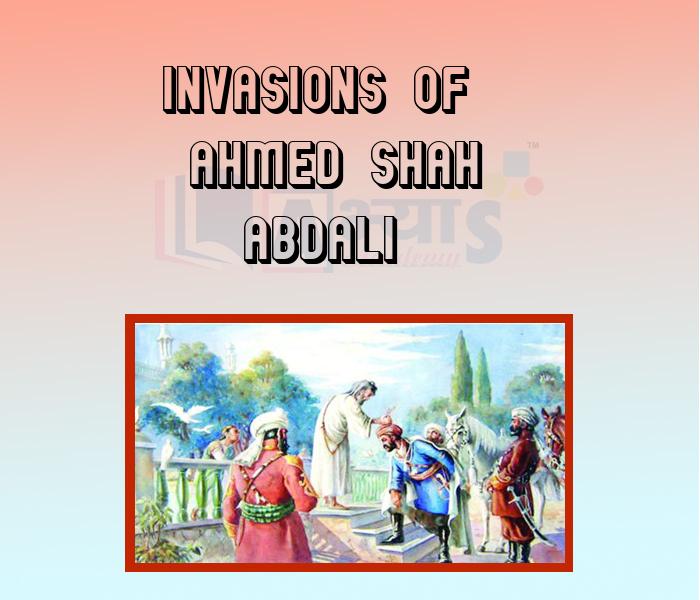Invasions of Ahmed Shah Abdali











Invasions of Ahmed Shah Abdali
INVASIONS OF AHMED SHAH ABDALIAfter the assassination of Nadir in 1747, one of his officers named Ahmad Shah, an Afghan chief of the Abdali clan, rose to power and succeeded in establishing himself as the independent ruler of Afghanistan. After having conquered Qandahar, Kabul, and Peshawar, Ahmad Shah Abdali invaded India for the first time, in Jan. 1748, with 12,000 veteran troops. But he was defeated at the battle of Manpur by Ahmad Shah, the Mughul heir-apparent, and Mir Manna, son of the deceased Wazir Qamar-ud-din, and was put to tight. Mir Mannu was appointed gevernor of the Punjab. However, before he could settle down, Ahmad Shah Abdali invaded Punjab for the second time in AD 1750 and conquered it after defeating him. Unsupported by the Delhi court, the Punjab governor found all resistance futile and admitted to the invader.
Abdali invaded India the third time in Dec. 1751, when he again defeated Mir Mannu, conquered Kashmir, and forced the Mughul Emperor, Ahmad Shah, to cede to him the country as far east as Sirhind. Thus, the Mughul Empire was further reduced in extent. Mir Mannu was now left as the Abdali governor in Lahore. After the death of Mir Mannu in Nov 1753, and that of his infant son and successor in May 1754, the province of Punjab fell into disorder and anarchy due largely to the wilfulness and caprice of theregent-mcther, Mughlani Begam. Ahmad Abdali invaded India for the fourth time in Nov. 1756, with greater determination, and arrived before Delhi on 23rd Jan 1757. The imperial city was "plundered and its unhappy people again subjected to pillage". Imad-ul-mulk surrendered and was pardoned by the invader, who obtained from the Mughul Emperor the formal cession of the Punjab, Kashmir, Sind, and the Sirhird district. After plundering the Jat country, South of Delhi, Abdali retired from India in April, 1757, with immense booty and many captives, leaving his son, Timur Shah, as his viceroy at Lahore with Jahan Khan, the able Afghan general, as the latter's Wazir.
Though Ahmad Shah Abdali had to return hurriedly from India, his invasions affected the history of India in several ways. Firstly, it accelerated the dismemberment of the tottering Mughul Empire. Secondly, itoffered a serious check to the rapidly spreading Maratha imperialism. Thirdly, it indirectly helped the rise of the Sikh power. "His career in India," observes a modern writer, "is very intimately a part of the Sikh struggle for independence." Lastly, the menace of Afghar invasion kept the English East India Companyin great anxicty, both during the lifetime of Ahmad Shah Abdali and for some time after his death.
Ahmed Shah Abdali made successful invasions in ____________ | |||
| Right Option : D | |||
| View Explanation | |||
Nadir Shah the persian invader died in_______ | |||
| Right Option : A | |||
| View Explanation | |||
Ahmad Shah Abdali invaded _____________________ for the second time in AD 1750 | |||
| Right Option : B | |||
| View Explanation | |||
Students / Parents Reviews [10]
My experience was very good with Abhyas academy. I am studying here from 6th class and I am satisfied by its results in my life. I improved a lot here ahead of school syllabus.

Ayan Ghosh
8thAbout Abhyas metholodology the teachers are very nice and hardworking toward students.The Centre Head Mrs Anu Sethi is also a brilliant teacher.Abhyas has taught me how to overcome problems and has always taken my doubts and suppoeted me.

Shreya Shrivastava
8thAbhyas is a complete education Institute. Here extreme care is taken by teacher with the help of regular exam. Extra classes also conducted by the institute, if the student is weak.

Om Umang
10thA marvelous experience with Abhyas. I am glad to share that my ward has achieved more than enough at the Ambala ABHYAS centre. Years have passed on and more and more he has gained. May the centre flourish and develop day by day by the grace of God.

Archit Segal
7thMy experience with Abhyas is very good. I have learnt many things here like vedic maths and reasoning also. Teachers here first take our doubts and then there are assignments to verify our weak points.

Shivam Rana
7thIt was good as the experience because as we had come here we had been improved in a such envirnment created here.Extra is taught which is beneficial for future.

Eshan Arora
8thMy experience with Abhyas academy is very good. I did not think that my every subject coming here will be so strong. The main thing is that the online tests had made me learn here more things.

Hiya Gupta
8thIt has a great methodology. Students here can get analysis to their test quickly.We can learn easily through PPTs and the testing methods are good. We know that where we have to practice

Barkha Arora
10thAbhyas Methodology is very good. It is based on according to student and each child manages accordingly to its properly. Methodology has improved the abilities of students to shine them in future.

Manish Kumar
10thOne of the best institutes to develope a child interest in studies.Provides SST and English knowledge also unlike other institutes. Teachers are co operative and friendly online tests andPPT develope practical knowledge also.
